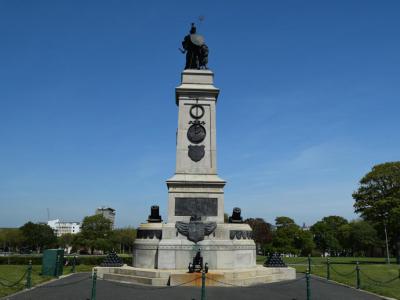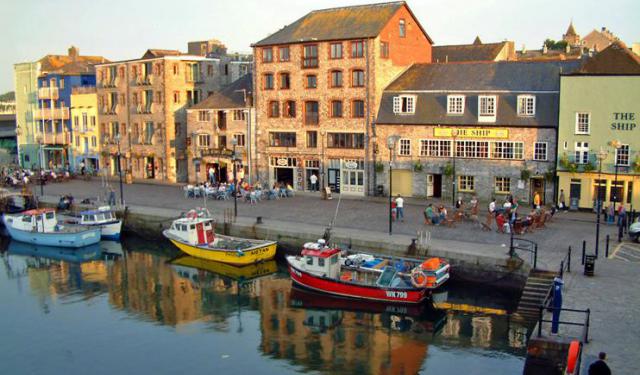National Armada Memorial, Plymouth
The National Armada Memorial stands as a proud testament on Plymouth Hoe, commemorating the 300th anniversary of the first sighting of the Spanish Armada by English captains stationed in the city. This event marked a pivotal moment in English history when the formidable Spanish Armada attempted an unsuccessful naval invasion.
News of the Armada’s approach reached Plymouth on the afternoon of 19 July 1588, and the fleet came into sight the following day. According to tradition, the English captains were engaged in a game of bowls on Plymouth Hoe when the tidings arrived. The famed commander Sir Francis Drake reportedly remarked, “There is time enough to play the game out first and thrash the Spaniards afterward,” epitomizing the legendary calm and confidence of the English forces.
The Armada Memorial's foundation stone was laid on 19 July 1888, marking 300 years since the first sighting. The event drew large crowds, with thousands arriving by excursion trains and a public holiday celebrated with a ceremony and banquet at the Guildhall. It was inaugurated on 21 October 1890 by Duke Alfred of Edinburgh, featuring civic pride and naval displays.
Designed by architect Herbert Gribble and sculpted by William Charles May, the granite structure features an octagonal base with steps leading up to a tall square plinth. This plinth is adorned with a shield surrounded by drapes and a crown, alongside a panel depicting the Battle of the Armada with the inscription “HE BLEW WITH HIS WINDS AND THEY WERE SCATTERED.” Additionally, the plinth includes a wreathed medallion and a chest adorned with a sculpted head believed to represent the Spanish admiral Sedonia.
Crowning the monument is an imposing 11-foot bronze statue of Britannia, a symbolic figure representing Great Britain, with a vigilant lion at her side. The National Armada Memorial had the patronage of Queen Victoria, further underscoring its importance as a national symbol.
In 1975, the memorial was designated a listed monument, ensuring its preservation as a significant piece of English heritage. The National Armada Memorial remains a powerful reminder of a defining moment in maritime history and a tribute to the valor and resilience of the nation.
News of the Armada’s approach reached Plymouth on the afternoon of 19 July 1588, and the fleet came into sight the following day. According to tradition, the English captains were engaged in a game of bowls on Plymouth Hoe when the tidings arrived. The famed commander Sir Francis Drake reportedly remarked, “There is time enough to play the game out first and thrash the Spaniards afterward,” epitomizing the legendary calm and confidence of the English forces.
The Armada Memorial's foundation stone was laid on 19 July 1888, marking 300 years since the first sighting. The event drew large crowds, with thousands arriving by excursion trains and a public holiday celebrated with a ceremony and banquet at the Guildhall. It was inaugurated on 21 October 1890 by Duke Alfred of Edinburgh, featuring civic pride and naval displays.
Designed by architect Herbert Gribble and sculpted by William Charles May, the granite structure features an octagonal base with steps leading up to a tall square plinth. This plinth is adorned with a shield surrounded by drapes and a crown, alongside a panel depicting the Battle of the Armada with the inscription “HE BLEW WITH HIS WINDS AND THEY WERE SCATTERED.” Additionally, the plinth includes a wreathed medallion and a chest adorned with a sculpted head believed to represent the Spanish admiral Sedonia.
Crowning the monument is an imposing 11-foot bronze statue of Britannia, a symbolic figure representing Great Britain, with a vigilant lion at her side. The National Armada Memorial had the patronage of Queen Victoria, further underscoring its importance as a national symbol.
In 1975, the memorial was designated a listed monument, ensuring its preservation as a significant piece of English heritage. The National Armada Memorial remains a powerful reminder of a defining moment in maritime history and a tribute to the valor and resilience of the nation.
Want to visit this sight? Check out these Self-Guided Walking Tours in Plymouth. Alternatively, you can download the mobile app "GPSmyCity: Walks in 1K+ Cities" from Apple App Store or Google Play Store. The app turns your mobile device to a personal tour guide and it works offline, so no data plan is needed when traveling abroad.
National Armada Memorial on Map
Sight Name: National Armada Memorial
Sight Location: Plymouth, England (See walking tours in Plymouth)
Sight Type: Attraction/Landmark
Guide(s) Containing This Sight:
Sight Location: Plymouth, England (See walking tours in Plymouth)
Sight Type: Attraction/Landmark
Guide(s) Containing This Sight:
Walking Tours in Plymouth, England
Create Your Own Walk in Plymouth
Creating your own self-guided walk in Plymouth is easy and fun. Choose the city attractions that you want to see and a walk route map will be created just for you. You can even set your hotel as the start point of the walk.
Plymouth Introduction Walking Tour
Plymouth's early history began in the Bronze Age when the first settlement emerged at Mount Batten. It is mentioned in Ptolemy's Geographia as a maritime outpost exporting bronze mirrors.
The settlement was a major port in the southwest of England in Roman times. It was surpassed as a port in the ninth century by the nearby wealthier village of Sutton, later called Plymouth.
... view more
Tour Duration: 1 Hour(s)
Travel Distance: 1.9 Km or 1.2 Miles
The settlement was a major port in the southwest of England in Roman times. It was surpassed as a port in the ninth century by the nearby wealthier village of Sutton, later called Plymouth.
... view more
Tour Duration: 1 Hour(s)
Travel Distance: 1.9 Km or 1.2 Miles
Pilgrim Fathers Trail
Back in the early 17th century, a group of English Puritans – nowadays reverently referred to as the Pilgrim Fathers – fled religious persecution in their homeland and established a colony in North America that later became known as Plymouth, Massachusetts. The Pilgrims embarked on their perilous journey across the Atlantic from Plymouth, England in 1620 aboard a ship called the Mayflower,... view more
Tour Duration: 1 Hour(s)
Travel Distance: 0.5 Km or 0.3 Miles
Tour Duration: 1 Hour(s)
Travel Distance: 0.5 Km or 0.3 Miles
Plymouth Hoe Walking Tour
Plymouth Hoe, referred to locally as the Hoe, is a large south-facing open public space in Plymouth with commanding views of Plymouth Sound, Drake's Island, and further afield into Cornwall. The name derives from the Anglo-Saxon word hoh, which means a sloping ridge shaped like an inverted foot and heel.
This part of town has always been a meeting place, where people would come regularly... view more
Tour Duration: 1 Hour(s)
Travel Distance: 0.7 Km or 0.4 Miles
This part of town has always been a meeting place, where people would come regularly... view more
Tour Duration: 1 Hour(s)
Travel Distance: 0.7 Km or 0.4 Miles






